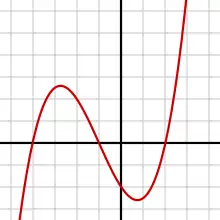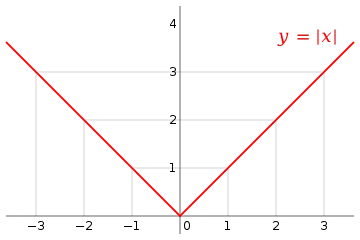Differentiable function
In mathematics, a differentiable function of one real variable is a function whose derivative exists at each point in its domain. In other words, the graph of a differentiable function has a non-vertical tangent line at each interior point in its domain. A differentiable function is smooth (the function is locally well approximated as a linear function at each interior point) and does not contain any break, angle, or cusp.

If x0 is an interior point in the domain of a function f, then f is said to be differentiable at x0 if the derivative exists. In other words, the graph of f has a non-vertical tangent line at the point (x0, f(x0)). f is said to be differentiable on U if it is differentiable at every point of U. f is said to be continuously differentiable if its derivative is also a continuous function over the domain of the function . Generally speaking, f is said to be of class if its first derivatives exist and are continuous over the domain of the function .
For a multivariable function, as shown here, the differentiability of it is something more than the existence of the partial derivatives of it.
Differentiability of real functions of one variable
A function , defined on an open set , is said to be differentiable at if the derivative
exists. This implies that the function is continuous at a.
This function f is said to be differentiable on U if it is differentiable at every point of U. In this case, the derivative of f is thus a function from U into
A continuous function is not necessarily differentiable, but a differentiable function is necessarily continuous (at every point where it is differentiable) as being shown below (in the section Differentiability and continuity). A function is said to be continuously differentiable if its derivative is also a continuous function; there exist functions that are differentiable but not continuously differentiable (an example is given in the section Differentiability classes).
Differentiability and continuity

.svg.png.webp)
If f is differentiable at a point x0, then f must also be continuous at x0. In particular, any differentiable function must be continuous at every point in its domain. The converse does not hold: a continuous function need not be differentiable. For example, a function with a bend, cusp, or vertical tangent may be continuous, but fails to be differentiable at the location of the anomaly.
Most functions that occur in practice have derivatives at all points or at almost every point. However, a result of Stefan Banach states that the set of functions that have a derivative at some point is a meagre set in the space of all continuous functions.[1] Informally, this means that differentiable functions are very atypical among continuous functions. The first known example of a function that is continuous everywhere but differentiable nowhere is the Weierstrass function.
Differentiability classes

.svg.png.webp)
A function is said to be continuously differentiable if the derivative exists and is itself a continuous function. Although the derivative of a differentiable function never has a jump discontinuity, it is possible for the derivative to have an essential discontinuity. For example, the function
is differentiable at 0, since
exists. However, for differentiation rules imply
which has no limit as Thus, this example shows the existence of a function that is differentiable but not continuously differentiable (i.e., the derivative is not a continuous function). Nevertheless, Darboux's theorem implies that the derivative of any function satisfies the conclusion of the intermediate value theorem.
Similarly to how continuous functions are said to be of class continuously differentiable functions are sometimes said to be of class . A function is of class if the first and second derivative of the function both exist and are continuous. More generally, a function is said to be of class if the first derivatives all exist and are continuous. If derivatives exist for all positive integers the function is smooth or equivalently, of class
Differentiability in higher dimensions
A function of several real variables f: Rm → Rn is said to be differentiable at a point x0 if there exists a linear map J: Rm → Rn such that
If a function is differentiable at x0, then all of the partial derivatives exist at x0, and the linear map J is given by the Jacobian matrix, an n × m matrix in this case. A similar formulation of the higher-dimensional derivative is provided by the fundamental increment lemma found in single-variable calculus.
If all the partial derivatives of a function exist in a neighborhood of a point x0 and are continuous at the point x0, then the function is differentiable at that point x0.
However, the existence of the partial derivatives (or even of all the directional derivatives) does not guarantee that a function is differentiable at a point. For example, the function f: R2 → R defined by
is not differentiable at (0, 0), but all of the partial derivatives and directional derivatives exist at this point. For a continuous example, the function
is not differentiable at (0, 0), but again all of the partial derivatives and directional derivatives exist.
Differentiability in complex analysis
In complex analysis, complex-differentiability is defined using the same definition as single-variable real functions. This is allowed by the possibility of dividing complex numbers. So, a function is said to be differentiable at when
Although this definition looks similar to the differentiability of single-variable real functions, it is however a more restrictive condition. A function , that is complex-differentiable at a point is automatically differentiable at that point, when viewed as a function . This is because the complex-differentiability implies that
However, a function can be differentiable as a multi-variable function, while not being complex-differentiable. For example, is differentiable at every point, viewed as the 2-variable real function , but it is not complex-differentiable at any point because the limit does not exist (e.g., it depends on the angle of approach).
Any function that is complex-differentiable in a neighborhood of a point is called holomorphic at that point. Such a function is necessarily infinitely differentiable, and in fact analytic.
Differentiable functions on manifolds
If M is a differentiable manifold, a real or complex-valued function f on M is said to be differentiable at a point p if it is differentiable with respect to some (or any) coordinate chart defined around p. If M and N are differentiable manifolds, a function f: M → N is said to be differentiable at a point p if it is differentiable with respect to some (or any) coordinate charts defined around p and f(p).
References
- Banach, S. (1931). "Über die Baire'sche Kategorie gewisser Funktionenmengen". Studia Math. 3 (1): 174–179. doi:10.4064/sm-3-1-174-179.. Cited by Hewitt, E; Stromberg, K (1963). Real and abstract analysis. Springer-Verlag. Theorem 17.8.
- Invexce. "Preparing for the AP Calculus AB Exam". KeepNotes. Rice University.